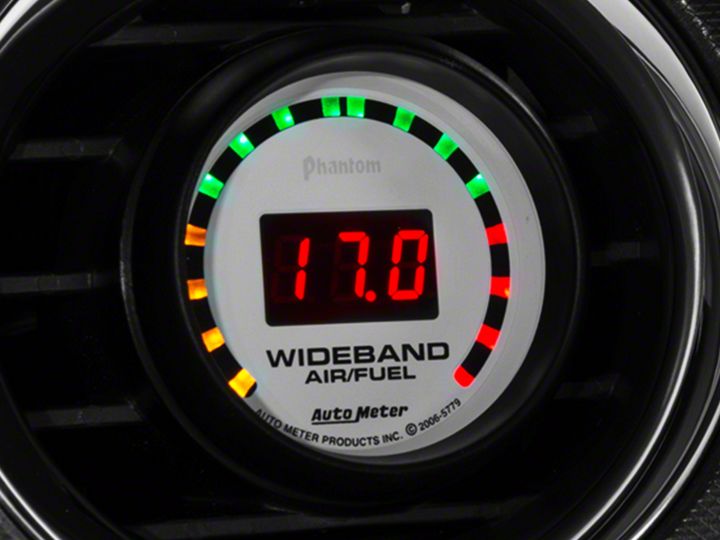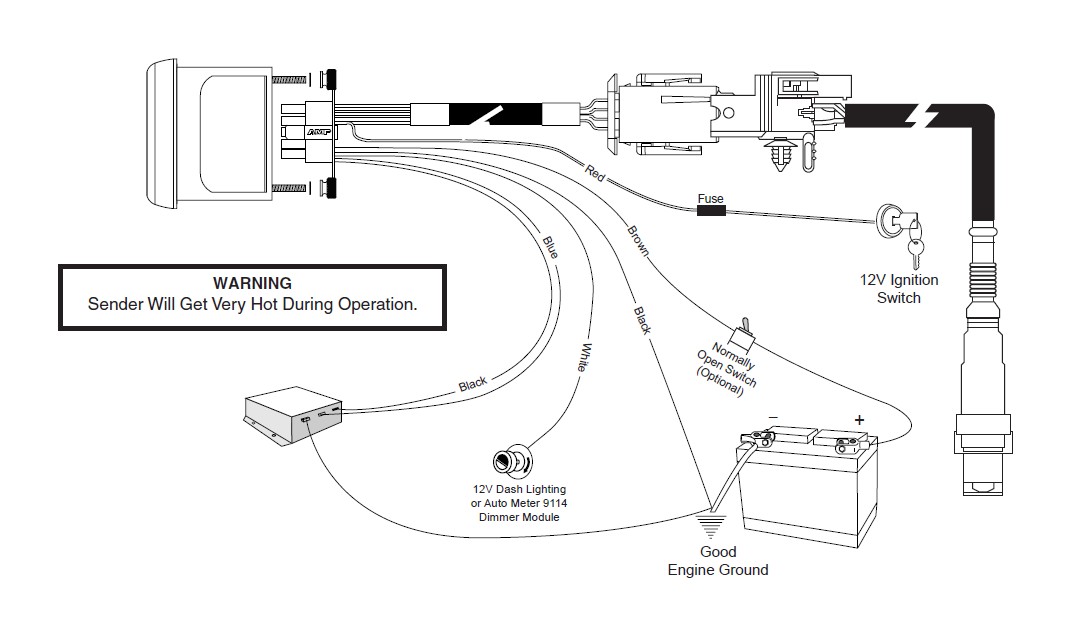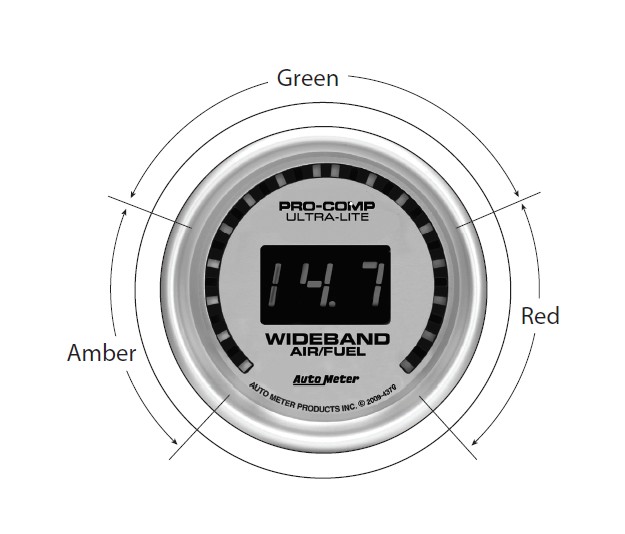
How to Install Auto Meter Phantom Wideband Air/Fuel Ratio Gauge - Digital (79-17 All) on your Ford Mustang

Shop Parts in this Guide
Installation
1. Disconnect the negative (-) battery cable.
2. Gauge can be mounted in a 21⁄16” dia. hole with brackets supplied. Gauge can also be mounted in Auto Meter Mounting Cup, or in Auto Meter Gauge Works Pods.
3. Wire gauge as shown.
Red Wire (Power):
Connect to a fused and switched 12V positive source that is turned on and off with the ignition switch. Place a 3 amp automotive fuse (available commercially) in line with this connection to protect your gauge. It is recommended that vehicles without alternators connect this wire to a separate switch or direct to the vehicle’s master cutoff switch. (See Heater Control Mode Section)
Black Wire (Ground):
Connect to good engine ground.
White Wire (Lighting):
Connect to dash lighting dimmer control.
Brown Wire (Heater Override):
Connect to a normally open switch. Connect the other switch terminal to battery positive ( ).
Blue Wire (Optional Data Logger Signal Output):
Connect to signal input( ) or Engine Management System or Data Acquisition unit.
Black Wire (Optional Data Logger Signal Ground):
Connect to signal input(-) on Engine Management system or Data Acquisition Unit.

Mounting Sensor
The heated oxygen sensor comes with a stainless steel weld-in bung, plug, and wiring harness. The oxygen sensor should be installed as close to the cylinder head as is reasonably possible so that the sensor reaches operating temperature quickly. If long tube headers are used, the oxygen sensor should be installed in the collector. If cast iron manifold(s) or shorty headers are used, install the sensor in the pipe just below the manifold. In multi-bank applications mounting in the left or right side is acceptable. Turbocharged applications should have sensor installed 4-5" after turbo on the down pipe.
Auto Meter recommends welding supplied stainless steel bung with a TIG welder.
1. The exhaust pipe in front of the sensor should not contain any pockets, projections, protrusions, edges, flex-tubes etc. to avoid accumulation of condensation. A downwards slope of the pipe is recommended. If the exhaust pipe is parallel to the ground, the sensor must be installed in the top half of the pipe to avoid damage to due to condensation
2. Tightening torque: 30-44 ft Ibs.
3. Avoid excessive heating of the sensor cable. Route sensor cable away from exhaust pipe.
4. The maximum temperature of the sensor on the outside of the exhaust fitting should not exceed 900o F.
The Air / Fuel Ratio Monitor is intended for use with unleaded gasoline.
NOTE: OK for use with Nitrous Oxide.
NOTE: Stoichiometric Air / Fuel Ratio is the chemically correct ratio where theoretically all of the oxygen and all of the fuel are consumed. The mixture is neither rich or lean.
Heater Control Mode:
All O2 sensors must be heated before an accurate signal is produced. Potential sensor damage can occur if the gauge begins to heat the sensor before the engine is running due to condensation that forms on the sensor tip and in the exhaust. To accommodate this, an internal trigger within the gauge will automatically begin heating the sensor when 12.5 volts or higher is seen on the Red wire (“Normal” operating mode). While the gauge does not require 12.5 volts to operate (12 volts will suffice), this voltage is used to indicate to the gauge that the engine is running, as most regulated charging systems will maintain 14 volts or higher. Once the gauge sees 12.5 volts, it will begin heating the sensor and transition from (---) to a 20 second countdown on the seven-segment display. When the countdown is complete, the sensor is heated, and the gauge will begin reading air/fuel ratio in real-time.
Sensor Heater:
In applications where a standard charging system is not used (vehicles without a regulated alternator, for example) there is an override available that will allow sensor heating to occur without the gauge reading a 12.5 volt trigger. To use this feature, connect the Brown wire from the gauge harness to one terminal of a normally open switch. Connect the second terminal of the switch to battery positive ( ), or to the keyed power from the ignition switch. To turn on the sensor heater, turn the normally open switch on after starting engine. The switch can be turned on momentarily or left on at all times.
Warning:
Fouling and/or permanent damage to the oxygen sensor over time will result if used with any of the following:
• Leaded gasoline and fuel additives containing lead
• 2 cycle gasoline (gas/oil mix)
• Diesel Fuel
• Nitromethane
• Excessively rich mixtures
If the Air/Fuel Ratio Monitor responds sluggish, the oxygen sensor is probably partially fouled and should be replaced.

LED Chart

Data Logger Output Range:
The Auto Meter Wideband Air/Fuel gauge has a signal output for supplying information to a Data Logger or engine management system.
The signal provided is a linear 0-4 volts output. 0 volts out equals 10.0 Air/Fuel Ratio, 4 volts out equals 17.0 Air/Fuel Ratio.
SERVICE
For service send your product to Auto Meter in a well packed shipping carton. Please include a note explaining what the problem is along with your phone number. If you are sending product back for Warranty adjustment, you must include a copy (or original) of your sales receipt from the place of purchase.

